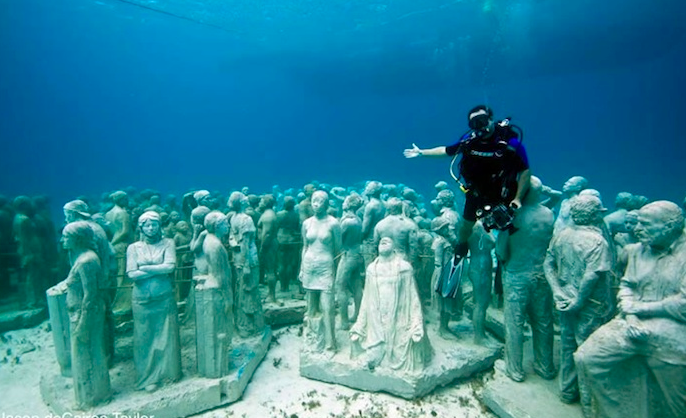The plan was formed in 2009 between the National Marine Park, the Cancun Nautical Association, and a British sculptor to create an interesting underwater sculpture museum that blends art, entertainment, and environmental science. It would hopefully delight and divert underwater visitors away from the overused reefs, while also providing an artificial reef for local marine life to colonize.

The Banker by Jason DeCaires Taylor. Photo: The Stills
The Underwater Museum of Art is located in the national park Costa Occidental Isla Mujeres, Punta Cancún y Punta Nizúcwaters off the island of Isla Mujeres, 13 kilometers (8 miles) off the coast of Cancun. The national park gets an estimated 750,000 visitors a year, with 450,000 of those visiting the reef area.
The nearby Manchones reef, a 12-kilometer-long (7.5-mile-long) natural marvel, proved so popular that inexperienced divers swarming it were bumping into the reef, accidentally breaking bits off and generally causing enough havoc that local authorities considered closing the reef down to give it time to recover.

Silent Evolution by Jason DeCaires Taylor. Photo: The Stills
There are now around 500 permanent life-sized sculptures fixed to the seabed, covering an area that’s approximately 420 square meters (4,500 square feet). The sculptures are made from a specialized ph-neutral material that promotes the growth of algae and corals, and it seems to be working as some of the sculptures are already showing coral growth.

Man on Fire by Jason DeCaires Taylor. Photo: The Stills
Although promoted as a conservation project, there are those who suggest that the interest is much more about business than saving the reef, and the underwater museum may actually divert attention away from bigger conservation problems facing the reef.
“It’s a good business,” Roberto Iglesias Prieto, a reef researcher at the Institute of Marine Sciences and Limnology, told Earth Island Journal. “The problem is that it’s sold as a conservation measure.”
Iglesias Prieto and others at the institute believe that the deterioration of the reef isn’t down to tourists, but water pollution from Cancun’s booming hotel industry. Wastewater from the city is treated, but is still high in nitrogen and phosphorous, which is spurring algae growth in the region and deteriorating the reef as the algae competes with the corals for nutrients.
The worry is that the algae will take over the statues too, quashing the coral before it can really start to form and encourage a thriving new habitat.
Source: iflscience.com



Comments are closed.